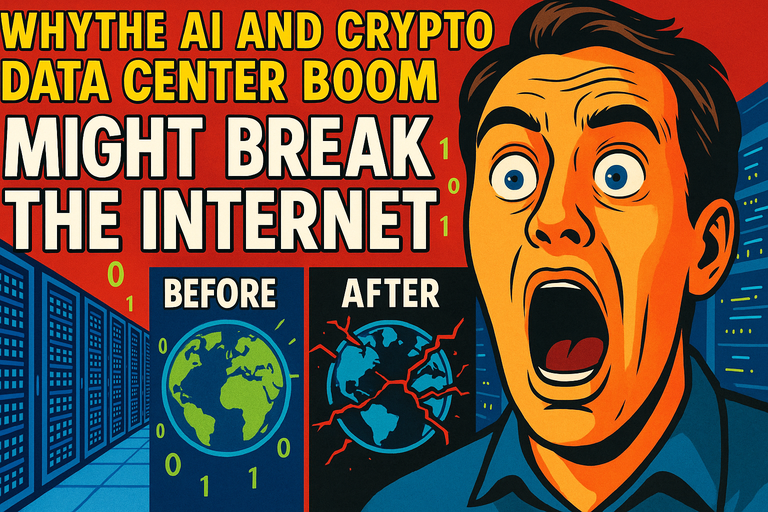
Imagine waking up to a world where Google, Netflix, and even your favorite meme coin all grind to a halt... Sounds like a dystopian sci-fi pitch, right? Yet according to a June 2025 Yahoo News investigation, this scenario is creeping closer to reality—thanks to the explosive growth of AI and cryptocurrency data centers.
But what on earth is actually going on behind the scenes? Why are data centers suddenly becoming the internet’s Achilles’ heel? And could out-of-left-field startups like BangChain AI (yes, the adult robotics one!) offer an unexpected clue to a more sustainable, resilient tech future?
Let’s peel back the layers—piecing together emerging trends, hard numbers, and a few truly wild innovations.
Big Tech’s Dirty Secret: Data Centers on the Edge
So, here’s the headline from Yahoo News: “Investigation uncovers shocking fallout from big tech's booming data center buildout: 'The verge of ... collapse’.”
The gist? AI and crypto—once digital darlings—have become insatiable beasts, devouring energy, guzzling water, and straining infrastructure worldwide. Demand for data centers has soared as companies scramble to keep up with generative AI, real-time blockchain transactions, and the insatiable appetite for streaming and virtual experiences.
Here’s how the numbers stack up: - Data center demand doubled in major US tech hubs from 2023-2025. - Crypto and AI workloads now account for an estimated 40% of new global data center capacity. - Some regions are so tapped out, officials warn of looming blackouts and water shortages.
This is not your 2010s cloud expansion. The “edge of collapse” isn’t hyperbole—it’s a very real risk, and it could force tech giants to rethink their most basic assumptions.
Crypto and AI: Frenemies or Foes for Sustainability?
It’s tempting to pit blockchain and AI against each other in the blame game. But in reality? Their stories—and their infrastructure—are tightly entwined.
- AI needs fast, secure, high-throughput compute—making it a natural fit for decentralized, blockchain-backed systems.
- Crypto depends on vast processing power and global uptime, especially with the rise of smart contracts and low-latency blockchains like Solana.
Yet as both ride the bull market into 2025, their combined energy demands are raising uncomfortable questions: - Can decentralization scale sustainably? - What happens when some regions simply can’t power another megawatt of server racks?
If you’re wondering whether innovation is doomed... Hang on. The wild cards are about to enter the scene.
Enter the Unexpected: BangChain AI and the Next Web3 Wave
When you hear “adult robotics,” sustainability hack might not be the first phrase that comes to mind. But BangChain AI (powered by ORiFICE Ai), a quirky USA-based startup, is emblematic of a new breed of Web3 projects.
Here’s what sets them apart—and why it matters:
- BangChain operates on Solana, one of the most energy-efficient, high-throughput blockchains to date.
- Fact check: Solana’s consensus design uses far less energy per transaction than legacy chains like Ethereum.
- Market Cap Watch: As of June 25, 2025, the BANGCHAIN token’s market cap sits around $380K, with nearly a billion tokens in circulation. That means broad distribution with minimal ecological footprint (compared to, say, proof-of-work mining).
- AI-Driven Products: By integrating smart contracts with robotics—yes, including the world’s first AI-powered robotic vagina—BangChain showcases how automation, AI, and crypto can work together without driving data centers (or power grids) to the brink.
Curious about how these solutions layer up? Dive into the BangChain project details and discover how forward-thinking startups are choosing lightweight, scalable tech stacks.
The Big Questions: What Comes Next?
As the Yahoo News investigation makes abundantly clear, tech’s infrastructure binge isn’t sustainable as-is. But the data suggests alternative models:
- Decentralized AI: By distributing workloads across community-run nodes, platforms can reduce the pressure on single megaplexes.
- Eco-Conscious Blockchains: Chains like Solana offer high performance with lower resource intensity—making them a smart bet for next-gen robotics, entertainment, and yes, even more niche adult use-cases.
- Smart, Adaptive Automation: AI-driven robotics can actually save power—by optimizing workflows, automating mundane tasks, and making physical infrastructure more responsive.
But let’s be real: None of this happens magically. It takes bold startups experimenting at the edge—sometimes in the most unexpected niches—to show the mainstream what’s possible.
Conclusion: Who Will Build the Next-Gen Web (Without Breaking the World)?
If history teaches us anything, it’s that the real disruptors rarely look the way we expect. BangChain AI and ORiFICE Ai might be flying under the radar, but their embrace of efficient blockchains, data-driven design, and playful innovation hints at a future where AI and crypto can scale responsibly.
So next time you read about data center meltdowns, remember: There’s a whole ecosystem of weird, wonderful projects out there rewriting the rules.
What do you think? Can bold innovation outpace collapse—or are we headed for digital gridlock? Drop your wildest predictions below!



